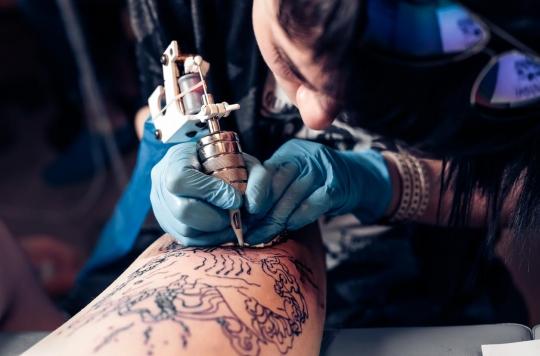The High Council for Public Health (HCSP) lists the potential dangers of tattoos on health, and issues new health recommendations.

- HIV, hepatitis, allergies… made in poor conditions, tattoos can be dangerous for your health.
- The practice of tattooing is growing very strongly in France: it concerns all ages and socio-professional backgrounds.
Faced with the enthusiasm of the French for this practice, the High Council for Public Health (HCSP) lists the potential dangers of tattoos on health, and issues new health recommendations. “In particular, it is a question of making recommendations on the additional actions that could be implemented concerning the risk of infection and the products used during tattooing and tattoo removal practices. say the authors of the report.
The practice of tattooing is growing very strongly in France: it concerns all ages and socio-professional backgrounds. In 2016, a survey estimated that 14% of French people had a tattoo (versus 10% in 2010); today, 26% of young people between the ages of 18 and 24 are tattooed. Currently, only a small fraction of tattooed people perform tattoo removal. About 20% of tattooed people regret at least one of their tattoos, and this is three times more common in men than in women, especially if this tattoo was made around the age of 18.
HIV, hepatitis B and C
There are many health risks associated with tattooing, permanent makeup and tattoo removal. “Complications related to tattooing can be acute or chronic, mainly with cutaneous, local or locoregional localization, more rarely systemic”, explains the HSCP. He pursues : “Infections can also be of bacterial or viral origin, of acute or later manifestation”.
Thus, the risk of HIV transmission is possible, and is increased when the tattoo is performed by a non-professional. In viral matter, the risk of contamination of the client by the hepatitis B or C virus during tattoos has also been well demonstrated, including when it is practiced by tattoo artists. “officials”.
Infections and allergies
Bacterial infections can be local or general, such as necrotizing fasciitis, endocarditis, or even septic shock. Contaminations by Treponema pallidum have also been described. The main germs involved in acute post-tattoo infections are Staphylococcus aureus and Streptococcus pyogenes. In addition to the germs present on the skin of the tattooed person or tattoo artist, infections are also linked to the contamination of ink pots, including those that have not yet been opened.
Allergic reactions are mainly observed with red tattoos; black tattoos are more often associated with nodules and the formation of foreign bodies by aggregation of pigments. Dermatosis can develop on the body drawing.
The potential risks associated with tattoos in healthcare
Finally, we must mention the potential risks associated with tattoos in the field of care:
– greater difficulty in identifying skin lesions hidden by the tattoo;
– an additional risk when performing certain procedures (epidural, lumbar puncture);
– a risk of migration of particles contained in tattoo inks, which can be the cause of erroneous diagnoses in medical imaging.
No direct causality between ink and cancer
Regarding the possible links between tattooing, ink and cancer, despite the possible actual presence of potentially carcinogenic or procarcinogenic products in tattoo inks, “The review of the literature shows that the number of skin cancers that appear in tattoos is low, with no direct causality demonstrated”, specifies the HSCP.
Some people shouldn’t get a tattoo
Faced with all of these risks, contraindications or situations requiring discussion prior to tattooing have been identified: pregnant women, patients with hepatitis B or C (vaccination against hepatitis B is strongly recommended before a tattoo), coagulation disorders (hemophilia) or under anticoagulant treatment, patients allergic to one of the substances used during tattooing (inks, pigments, metals), kidney failure, diabetes, heart disease, autoimmune diseases, HIV-positive people, and finally subjects susceptible to mucocutaneous herpes outbreaks.
For patients with chronic dermatosis, it is recommended to warn them of the possible risks of locating their dermatosis on the tattoo. “Any patient with a chronic condition or immunosuppression should contact their doctor to discuss the possibility of getting a tattoo”, summarize the experts. “The contraindications of permanent makeup are similar to those of tattooing”, they conclude.
The recommendations of HCSP to improve health security
In order to improve the health safety of tattoos, the HCSP recommends, among other things:
– for minors, only authorize the act of tattooing from the age of 16 with the written consent of a person holding parental authority, then limit the area and the overall surface of the tattoo.
– consider a change in the regulatory texts allowing the arrival of a professional tattoo artist in penitentiary establishments.
– for tattoo removal, prohibit any use of chemical products and reserve this act for doctors, with exclusive use of the laser adapted to this act.
The 42 other recommendations of the HCSP aim to guarantee the “6B” throughout the tattoo journey: “the right act carried out by the right professional with the right product, with the right person, with good information and good follow-up/good monitoring”.

.















